House of McNally
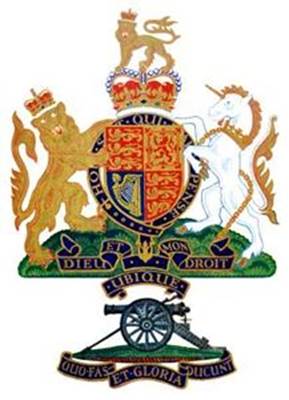
House of McNally

Soldier 1645 Sergeant in the Royal Artillery 1838-1860 Link to their children 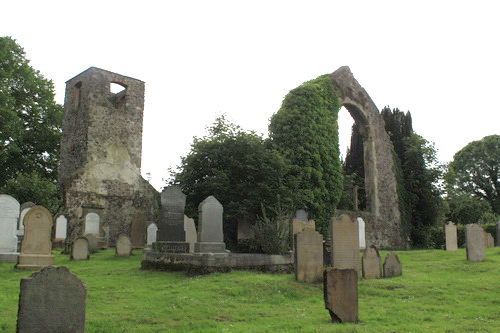 Magheralin Old Church Henry McNally Senior was the eldest son of Henry McNally the Elder, by his wife Mary, follow link provided for more information about his parents, siblings and descendants. Henry McNally Senior, according to his Army Records, was born in 1819 in the Parish of Maralin (Magheralin)(1) which lies 3 miles N.E. of Lurgan in what has today become part of Northern Ireland. It is a small village nestling right on the border between the counties of Armagh and Down.
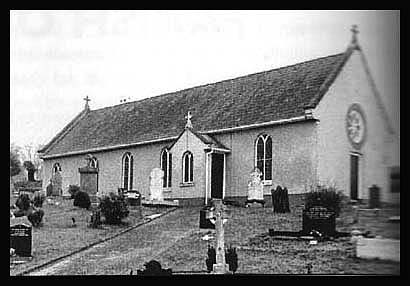 St Mary's Church Lisnagade Henry's parents were Catholic by persuasion so they had him baptised 17km S.W. in the Roman Catholic Church of St Mary's at Lisnagade in the parish of Aghaderg which lies within the union of Banbridge(2). His entry in the parish baptism register is simply recorded as "Henry McNally, of Henry and Mary on 26th April 1819'. We know from his Army record that prior to his enlistment as a teenager he worked locally as a weaver and the vast majority of weavers in Maralin (over 250) were employed at Springfield where they manufactured cambric. 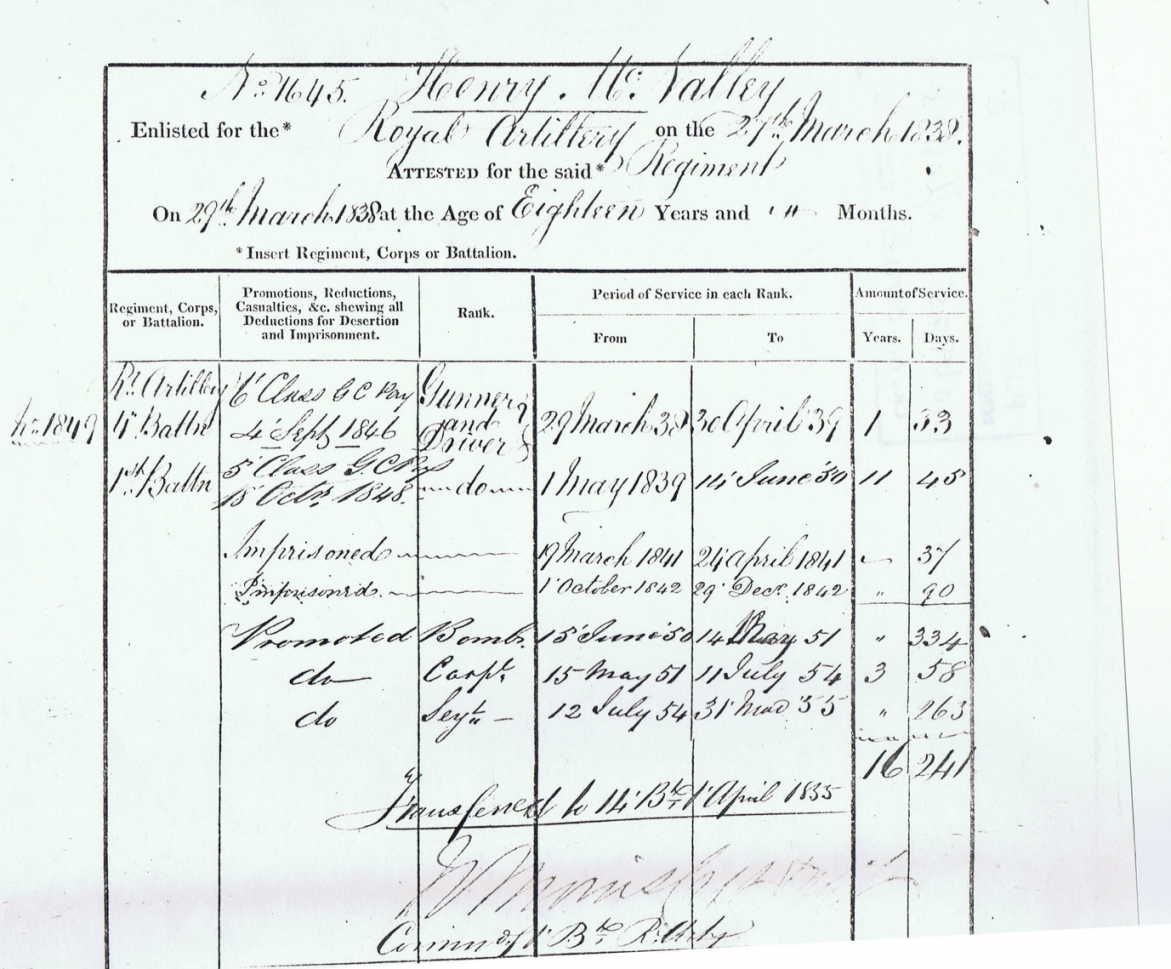 WO 69/85 : 1st Page only of his enlistment papers Like his father Henry McNally joined the British Army. The main reasons recruits enlisted was a bounty of £4 (which doubled to £8 in January 1855), security of lodging, regular sustenance, and the promise of a pension. The situation in Ireland at this time also led thousands of Irishmen to emigrate. The population was largely pauper and mainly existed on a diet of potato. The agricultural system was barely adequate to support the population in years of average harvest and thousands starved if the potato crop failed (as it did only a few years later(3) ). The population continued to increase and unlike England there was no corresponding increase in agricultural efficiency or the amount of land under tillage. It was rich ground therefore for recruitment to the British Army which offered security where there was none, the chance to travel which was otherwise virtually impossible for the poor, or a means of escape for the rest. At it's peak in 1830 42.2% of Infantry in the British Army were from Ireland and although it gradually declined it was still around 38% when Henry joined. Henry travelled to Lisburn which lies about 12 miles east of Magheralin and signed the enlistment papers on the 27th March 1838 when he joined the Royal Artillery. His father had also been a Soldier in the British Army and Henry McNally's descendants were to maintain a presence in the Royal Artillery for over another Century down to his great grandson Christopher McNally. From his military records I know him to have been 5 foot 7 inches tall with grey eyes, light brown hair and a fresh complexion. He was also literate with a neat flowing hand. The standard rate of pay for a gunner/driver at the time of his enlistment was one shilling three and a quarter pence per day, or one pound eighteen shillings and one and a half pence for a 30 day month(4) . Six pence per day was deducted for rations, although this was reduced when prices fell. From the Royal Artillery depot in Lisburn he was temporarily assigned to the 4th Battalion Adjutants detachment for training before transfer to Woolwich and the first Battalion. Army diet was regular and sufficient, 1 pound of meat and three quarters of a pound of bread per man per day. Monotony however was unrelieved by any culinary competence in its preparation. Barracks were generally overcrowded, sometimes chronic (the regulation one foot gap between beds often ignored). The bad air was compounded by the small fuel allowance and the difficulties of heating a large room with the result that it was never properly ventilated. Washing facilities were often confined to a pump in the backyard. The immediate consequence of poor accommodation was bad health. The London Barracks were particularly associated with sickness and it is not surprising to see Henry listed as sick on 28th February 1839(5) . The usual construction was an oblong apartment having a door at one end and a fire place at the other with rows of iron bedsteads on either side which were folded up in daytime. There were also tables and benches, the oblong chamber serving as a dormitory, a dining room, and a washing place for women. The United Service Journal in 1837 concluded that “At present the jails and bridewells are far beyond them and they rank only with asylums for the insane or some of the new poorhouses.”  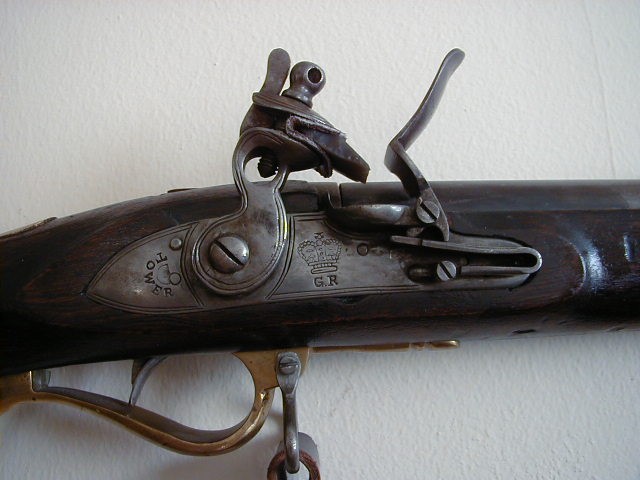 At Woolwich Henry would have been issued with his own flintlock musket (See picture above) as he arrived on 30th April 1839 and flintlock muskets remained in general issue for the Royal Artillery until they started replacement in 1840. 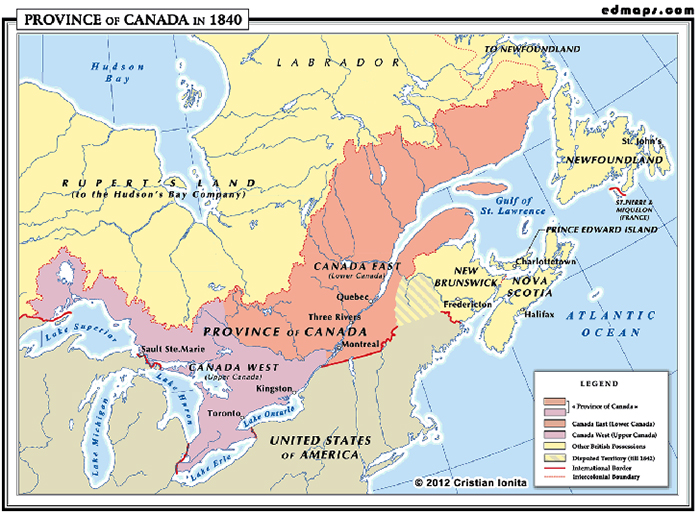 Aged 19 years Henry was transferred to the 7th Company RA which was then on duty in Canada. On the 1st August 1839 he joined a freight ship (named Stakesby) bound for Quebec together with 15 other soldiers from the Royal Artillery.
After the Napoleonic Wars the Tories were in power and they reduced the Armed Forces to a peace time level. For the colonies this consisted of 48,000 men distributed mainly between Gibraltar, Malta, Ionian Islands, West Indies, British North America, The Cape of Good Hope, Ceylon, and New South Wales. This constituted approximately half the entire Army(7)
In 1791 the British Parliament had divided Canada into two provinces(8) Lower Canada, which consisted of the French communities around Quebec and Montreal, and; Upper Canada which was the British Settlement near the Great Lakes Region. The natural suspicious and jealousies of the two provinces however led in 1837 to rebellions in both(9). After the rebellions were crushed Lord Durham, a theorist, and radical leader, was sent to Canada to investigate the situation. His report of the affairs of British North America (1839) recommended that Canada should be reunited and given self government. His recommendations were implemented in 1867 with the British North America Act which made Canada into the first of the self governing dominions in the British Empire and set a new pattern for the future.
Things got worse however with Henry being imprisoned on the 19th March 1841 for breaking out of barracks. He was tried by Garrison Court Martial on the 25th March and sentenced to one lunar months imprisonment with hard labour and 2 years loss of good conduct pay. Investigation of the Garrison Court Records however shows Henry listed as undergoing stoppages of pay for habitual drunkenness. (10b) It is important to get this into perspective. By the 19th Century excessive consumption of alcohol was a habit so engrained in British Military life it bedevilled the Army at every turn. As an example official returns show that the Rifle Brigade although enjoying an excellent reputation for good conduct and high morale had 121 cases of drunkenness in its 2nd Battalion and 124 in its reserve Battalion in December 1842 alone. That is to say about one in eight men were arrested on this charge in one month. It was obviously the same in Henry’s company as there is a listing in WO10/1849 (Shown below) that records that 10 men of the 7th Company 1st battalion RA were all undergoing deductions from pay for habitual drunkenness during the month of Nov 1841 (one among them was Henry). for Habitual Drunkenness - Nov 1841 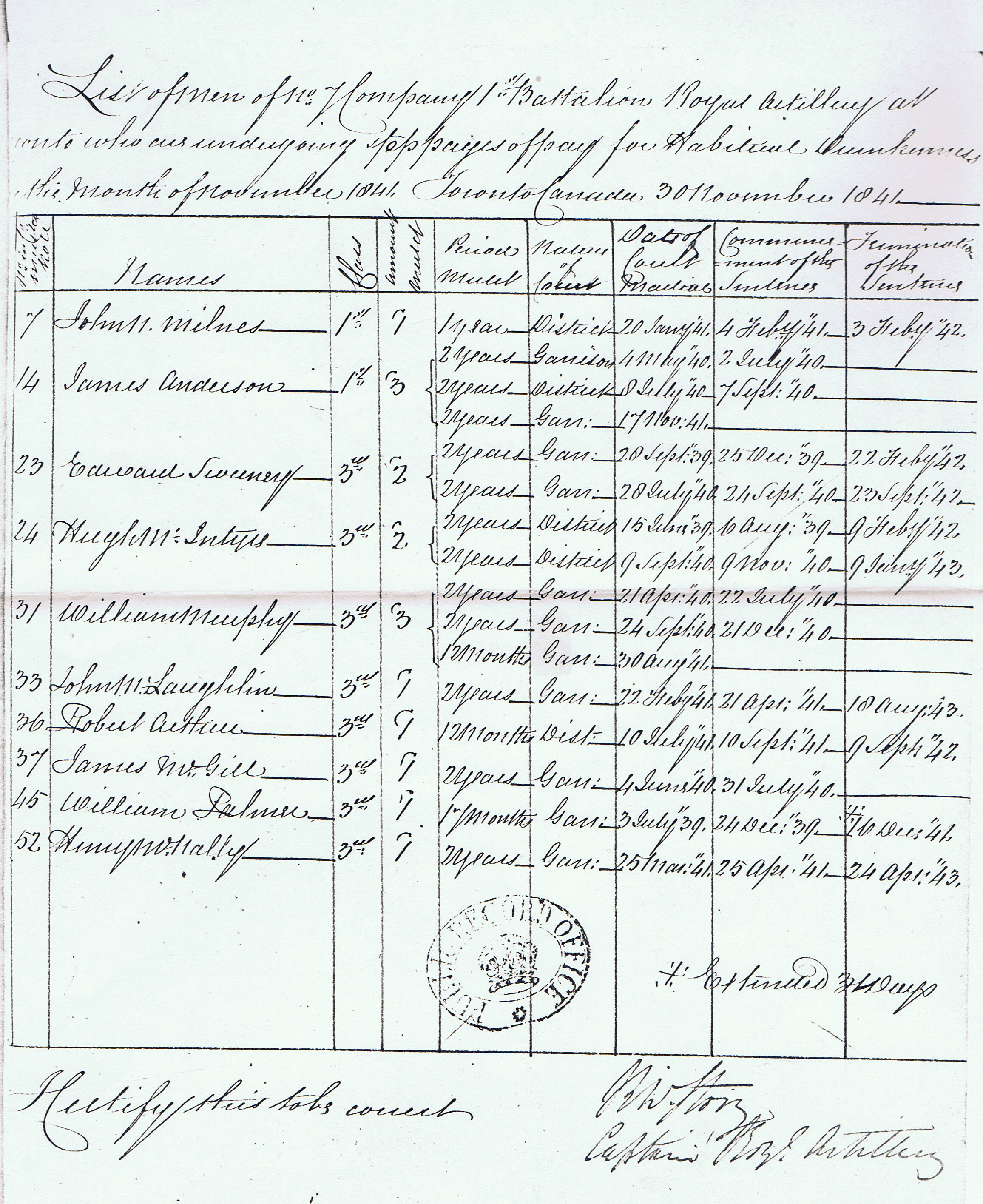 It is also clear that Henry was dealt with extremely lightly by the Court Martial, because it was such a common problem. Sentences for other offences were often savage as can be seen from the following examples taken from Court Martial Records for the same period(12) .
Striking a Corporal - Transportation for life. Drunk - 6 months hard labour with pay stoppages Drunk and violent - Transportation 7 years Indecent Conduct - 200 lashes Striking a Sergeant - 12 months imprisonment Striking a Sergeant - 14 years imprisonment Theft - Transportation 7 years
In 1846 following the death of a private it was reduced further to 50 lashes. Deserters (and there were 2,417 from the British Army in 1846) were branded mainly to prevent them from re-enlisting and claiming the bounty again rather than as a deterrent. The reduction in flogging put a greater onus on other forms of punishment and these were divided into minor punishments awarded by Regiment and major punishments given out by District or General Courts Marshal. To avoid breach of contract a stoppage of pay could only be imposed to make up losses incurred by damage for habitual drunkenness. Commanders frequently relied on their powers of billing up men in the black hole for up to 2 days and of confining to Barracks for up to two months. Henry’s sentence of “Breaking out of Barracks” is therefore almost certainly because he had been confined there under such an order. Major punishments – At first transportation as discharged without liberty but main recourse was imprisonment. They generally wanted men returned to effective service as soon as possible. They therefore concentrated on short sharp shock treatment. Inmates underwent hard labour for a maximum of 10 hours a day with solitary confinement for the rest. A normal sentence at this time was 100 days. It could not however have had the desired affect because on the 14th August 1842 Henry was again admitted to the Royal Ordnance Hospital and this time was not released until the 15th September(11) . On the 1st October he was detained for a second time and again tried by Garrison Court Martial for habitual drunkenness and sentenced on the 7th October to 3 lunar months imprisonment with hard labour and loss of one years good conduct pay.(12 & 13) Money deducted in this way was credited to public account and the time served in prison did not count against the 21 years service required to qualify for a pension. His conduct however was described on his discharge papers 18 years later as very good which gives a fair indication of the light in which the authorities viewed this type of offence.(1) Henry returned from Canada with the rest of the company at the end of their tour of duty. They embarked at Quebec on another freight ship (the Pedel) on the 10th June 1843 and arrived at Woolwich on the 30th of the same month(14) . There then followed a series of guard duties at Woolwich and Purfleet until the company was transferred to the barracks at Portobello in Dublin Ireland in April 1845.(15) Portobello Barracks were built between 1810 and 1815 and have been in continual use ever since. It has since been renamed 'Cathal Brugha' Barracks. Within a year to eighteen months of his arrival in Dublin Henry met and married a young lady called Mary HOBEN (1826-1904). According to the 1871 and 1901 Census returns she was born 64 miles inland from Dublin (c1826/7) in a small town often referred to as 'The Catholic Parish of Mountrath' in the County of Laois. It had a convent dedicated to to St Brigid established there in 1809 which was soon followed by a Monastery to St Patrick. Both convent and monastery communities were employed in the education of Roman Catholic pupils. Many records in Ireland have not survived from this period but it seems likely that they married in the Dublin area around late 1845 or early 1846(16) .
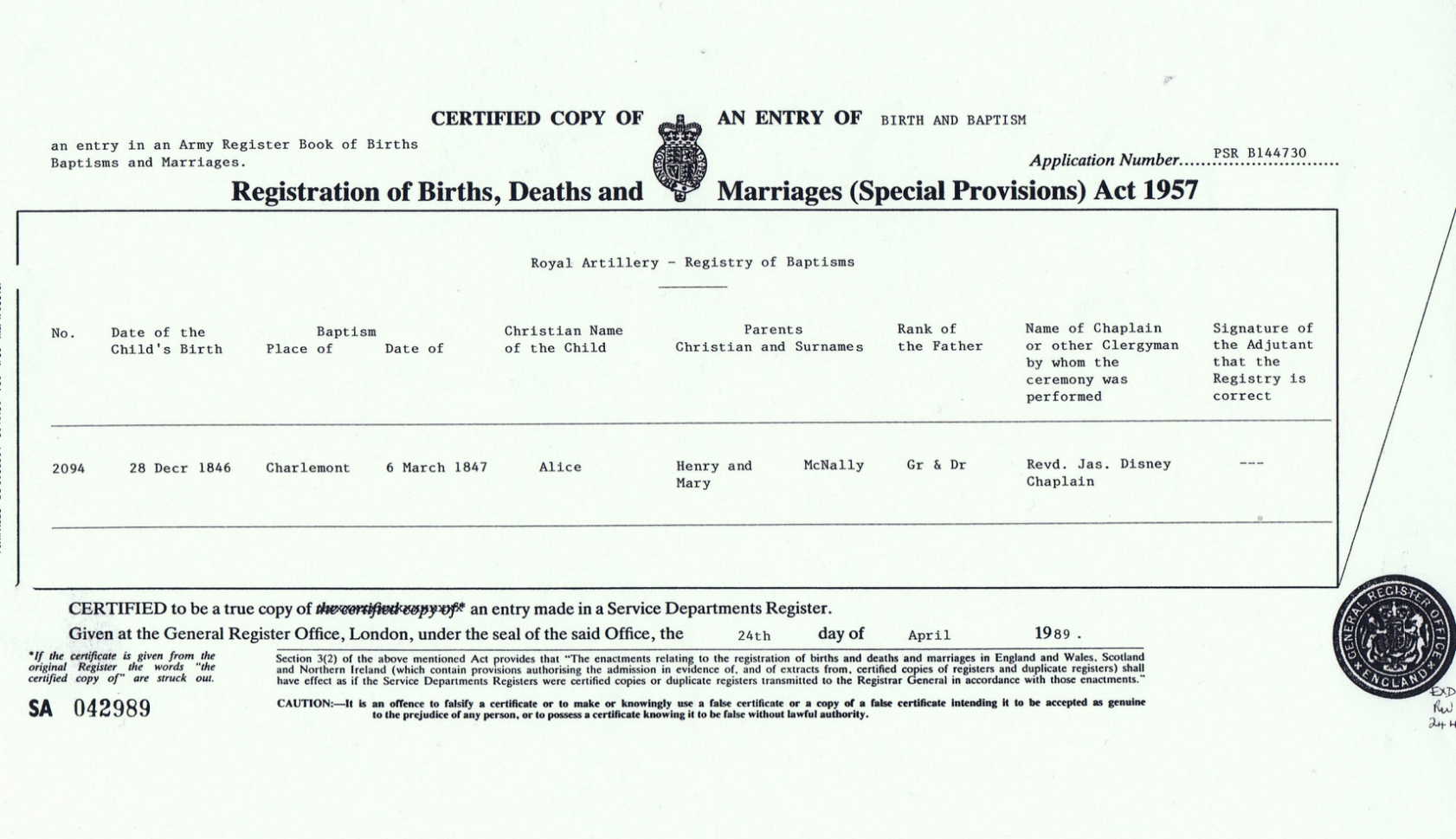
The Regimental Pay Musters show that Henry remained at Charlemont until 29th Feb 1848(17) when his Company, under the command of Captain H.P.Goodenough, was again assigned to Overseas duty, this time to the West Indies. The company therefore returned to Portobello in Dublin where one of the gunners serving with him (Francis Kearney) died and he bought some of his effects. The reason this is recorded in the pay musters is that the money raised by such sales of personal items had to be sent to the next of kin together with any outstanding pay. In August 1848 Henry received a Good Conduct pay award which was to be paid to him from the 18th October, but I can't see any increase in the amount he actually received. The Company arrived back a Woolwich in September 1848. While waiting for suitable transport Henry Mc Nally had to take a turn of guard duty at the tower of London(18) . 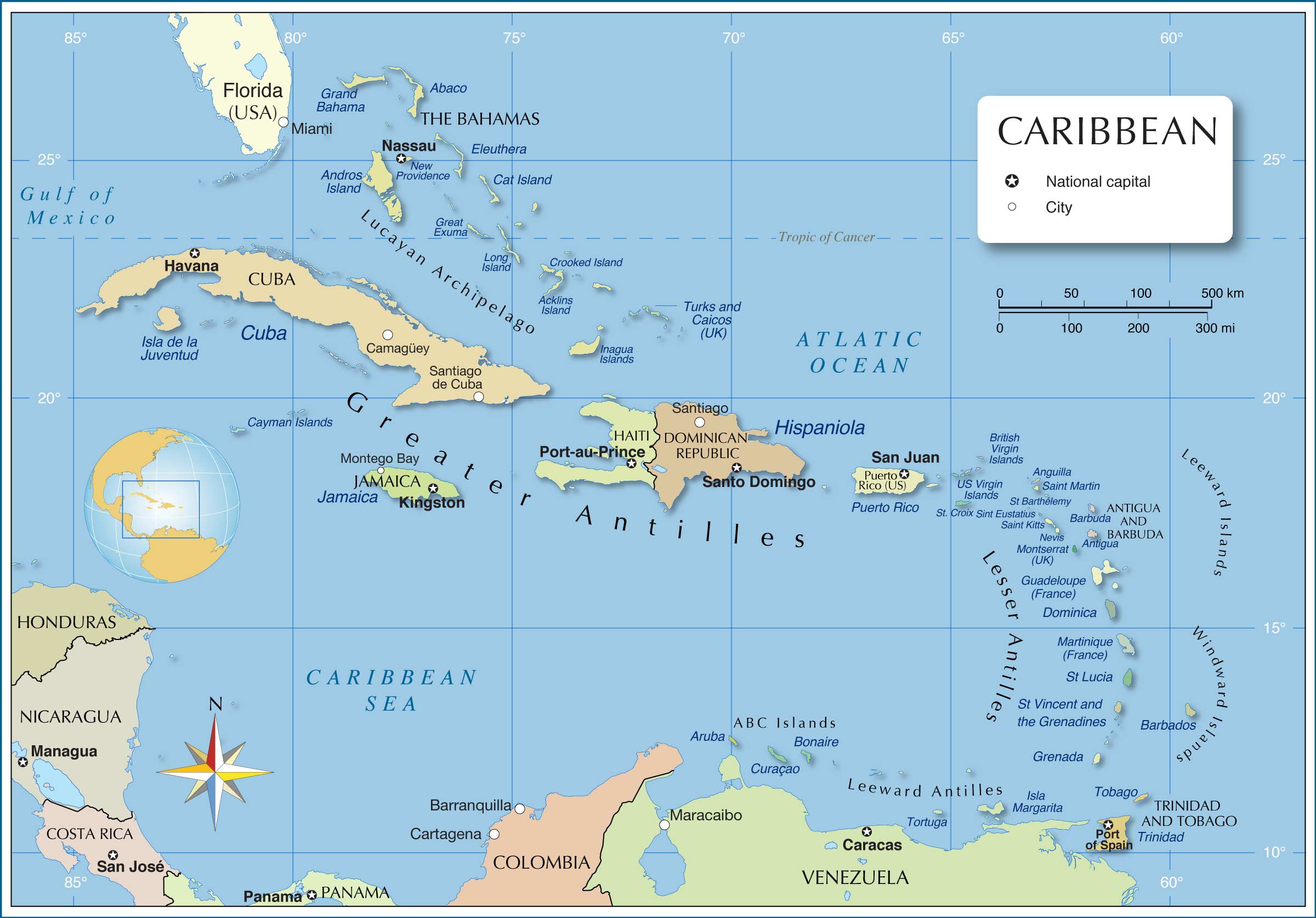 [For Dominica see the middle of 'Lesser Antilles' North East of Caracas Venezuela] The 7th Company under the command of Captain H.P. Goodenough, embarked on a troop ship (The Athol) at Woolwich on the 11th October 1848(19) . There were eight officers and forty seven gunners in all. The Master of the 'Athol' Commander Pearn, also embarked Captain the Hon. R Handcock's Company 1st Battalion of the RA, for Barbados and Major Barnaby's Company, 6th Battalion for Jamaica. The troop ship was towed down river at 12 o'clock by the Monkey Steam Vessel and set sail on the 12th. Also on board were strong relief detachments of the 2nd, 4th, 6th, and 9th Battalions. The 'Athol', according to the ships log(20), had a fairly uneventful voyage apart from the need to punish a marine called Patrick Brody who received 24 lashes for disobedience and insolence. After a journey of 19 days they arrived at Barbados and debarked on 31st October 1848. Henry was assigned to a small detachment consisting of a Lieutenant, three Bombardiers and twelve gunners on the island of Dominica. Henry, Mary, & Alice arrived on the 22nd November 1848.(21) Dominica was named after the Lord's Day on which it was discovered by Columbus in 1493.(22) It was first colonised by the French in 1632 but guaranteed as a neutral reserve for Caribs by France and England in 1660. English attempts to possess the island were defeated by the death of Warner in 1674. It was eventually evacuated by the French in 1730 and a further treaty guaranteed its neutrality in 1748. The French however infringed the treaty and the island was captured by the British in 1761. The French then invaded from Martinique in 1778 and it was not restored until 1783 by which time all its established trade had been ruined. One of the decisive factors leading to the restoration under the treaty of Versailles was the battle of Dominica (or Battle of the Saints) on 12th April 1782 which resulted in the destruction of the French Naval Power in the West Indies. There was also a serious slave uprising in 1791 in San Domingo (then a French possession – now the Dominican Republic) when 100,000 slaves rose and massacred 2,000 whites. The uprising quickly spread to other islands in the region. This included a small uprising on Dominica which was suppressed in 1791. Dominica was again attacked in 1795 and ravaged by the French in 1805 but remained firmly in British hands. All slave throughout the British Empire were freed by the Slavery Abolotion Act of 1833. A report on the health of British Forces in the West Indies was published 11 years earlier in 1837 and showed the following death rates. As a direct result of this report certain garrisns were withdrawn to healthier locations. 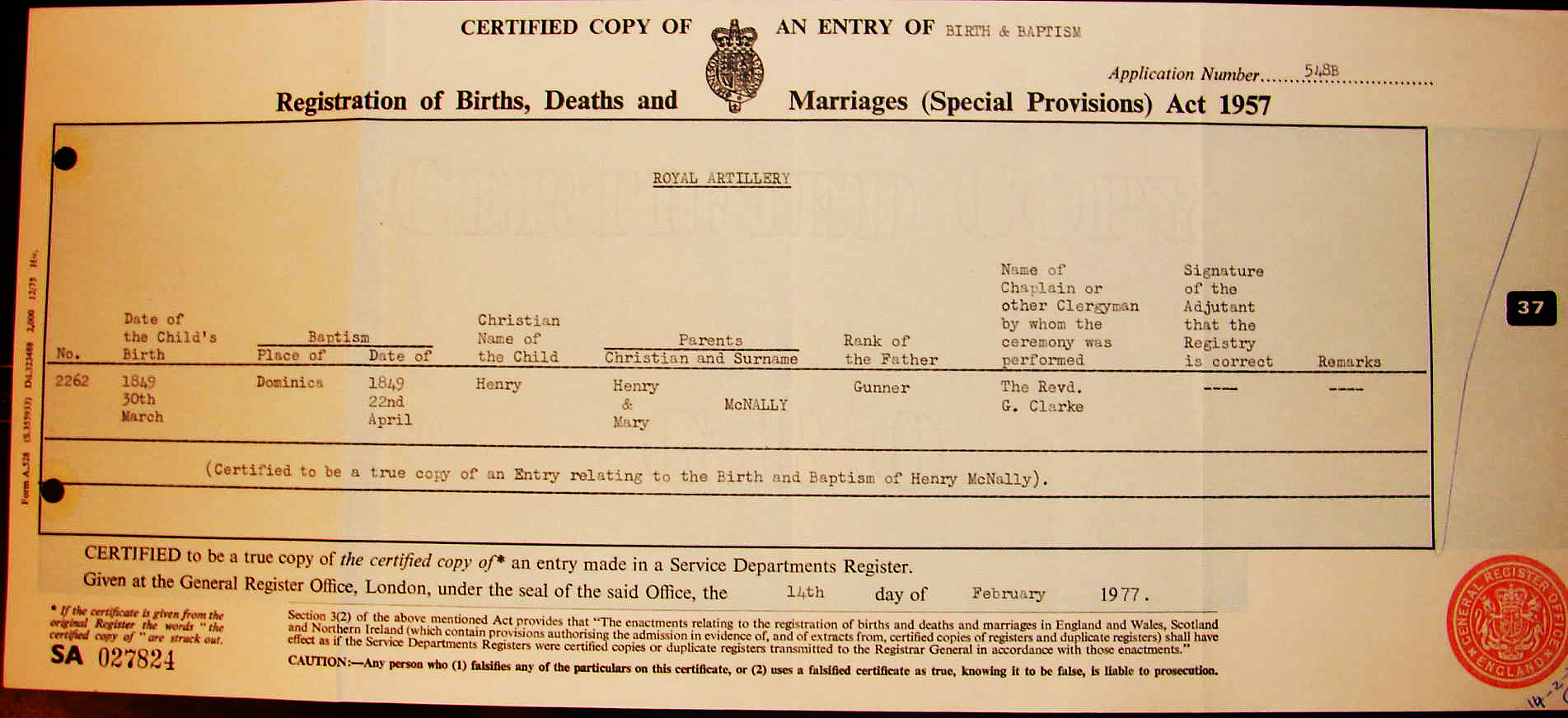 [Royal Artillery Birth and Baptism Certificate for Henry McNALLY Junior] Henry's wife Mary gave birth on Dominica to their second child on the 30th March 1849 (23) . He was named Henry McNALLY after his father and baptised on 22nd April 1849 by the Revd G Clarke. Henry was temporarily promoted to the rank of Bombardier on 7th May 1849 with 5th Class good conduct pay which meant a rise of 1d per day to 1s 5¼.d or £2.3.1½.d per 30 day month (24) . Henry's promotion was confirmed on the 15th June 1850 when the existing Bombardier (a man called Campbell) was reduced to the rank of gunner by District Court Martial. Henry had to visit Barbados, probably as escort to the former Bombardier for detention on the 25th of the same month. He returned to Dominica by the Royal Mail Steamship "Medway" on 10th July arriving the next day(25) . His pay was now boosted to 2/2d per day, and we have his neat signature on the pay muster for this month.
On 2nd April 1851 Henry's third child Frances Ann McNALLY was born on the Island of Dominica(27) . It was only justice that the system he fell foul of should later give him a helping hand. It happened a second time when on the 15th May 1851 the present Corporal, Denis Morgan, was reduced to the rank of gunner by Court Martial.(28) Henry was promoted the following day with a further increase in pay to 2.4d per day. The Lieutenant in charge was subsequently promoted which meant that the detachment was left in joint charge of the two Corporals during November 1851.(29) Temporary command was then handed over to an Ensign (Mr HB Brody) of the 69th Regiment until a replacement arrived in January 1852. Unfortunately at this point the Army pay musters have not survived, but between April and September 1852 Corporal Henry McNally transferred to a similar small detachment on the Island of St Vincent. At least, as already described in section 8 above, it had a much healtier climate. We know that Mary with their children Alice, Henry junior and Frances Ann went with him as Mary conceived their next child there in February 1853.
During Henry's stay, which lasted approx one year, there was little activity on the island and a change in military strategy resulted in the withdrawal of the entire detachment of 21 soldiers.
H.M.S Megaera 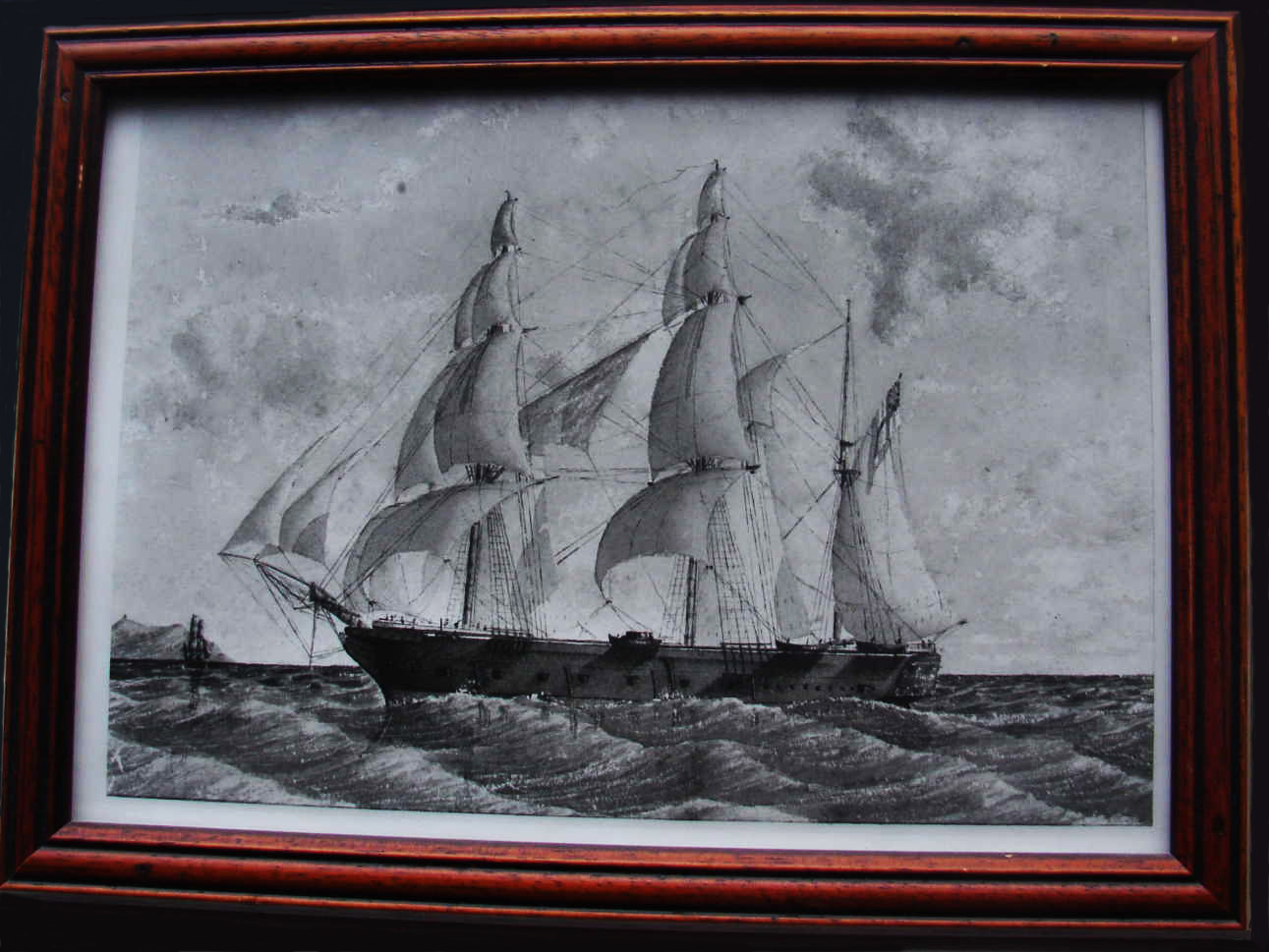 They all boarded a three masted sailing ship called “H.M.S Megaera” on the 10th May 1853 bound for Barbados. A portrait of the “Megaera” painted in 1869 in watercolours by midshipman TCD Thompson, who served on board the Megaera, is held in the National Maritime Museum in London. A Black and White photograph of this picture was purchased by me on 6th February 1980 as shown above. A better image of this painting in colour is now available on line with more information about her history. 13. Homeward Bound on 'HMS Vulcan' - 4th Nov 1853 The company then mustered at St Ann's barracks and on the 4th November assembled very early in the morning at the quayside. Alongside was 1,760 tons of Her Majesty's Steam Frigate “H.M.S Vulcan.” She had only been launched on 27th January 1849, so was a relatively new troopship. As Henry drew alongside he cannot have failed to have been impressed. She could take over 330 officers and men and had a length of 220 feet, beam of over 41 feet and draught of 26 feet(31) . The ships log shows that whilst at anchor at 6am she was “employed hoisting in baggage and preparing for sea. Embarked Company of Royal Artillery 4 officers, 2 ladies, 4 children, and 75 rank and file, together with 10 women and 23 children.” Among these were Corporal Henry Mc Nally, his heavily pregnant wife Mary, and their children (Alice a month short of her 7th birthday, Henry aged 4 years 7 months and Frances 2 years 7 months) (32) . They cleared the harbour and loosed sails at 12 o’clock. 14. Death & Burial of Henry's child at Sea - 5th Nov 1853 On the very next day, Saturday the 5th November 1853, there is a very moving entry in the ships log “4.30 departed this life the infant of Corporal Mc Nally Royal Artillery” and later at 1.40am “Committed the body of the deceased to the deep.” Amazingly the ships log also records the approx position of the burial of Henry’s fourth child, giving the distance from port, speed, and direction of travel. As the child does not appear to have been named and we know his other children survived this probably means that Mary gave birth to a stillborn child on board. (Link to images extracted from HMS VULCAN Ships Log.) We are fortunate that the return of H.M.S Vulcan which docked at Woolwich on 14th January 1853 was covered extensively in the Times Newspaper for Tuesday January 17th 1854. I have quoted verbatim: - “The Vulcan iron screw steam troopship, Commander Edward P.B.Von Donop, arrived off Gravesend on Saturday afternoon, and cast anchor there for the purpose of landing 24 soldiers, 18 women, and 86 orphan children brought home from Bermuda and other islands in the West Indies, the orphans being the sons and daughters of soldiers who had died of the late prevalent fever. The soldiers, women, and children were sent by the North Kent Railway to Chatham, where depots of the regiments to which they belonged are stationed. The Vulcan left Gravesend about 11oclock and arrived at Woolwich about 1 o’clock pm when she was brought up at the dockyard, for the convenience of landing the three companies of Royal Artillery she brought home from Jamaica, Barbados, and Bermuda. The companies landed at the dockyard at 3 o’clock p.m. today, and marched up to the Artillery barracks headed by the band of the regiment, the widows, and children having been previously landed under the immediate superintendence of the Rev. Mr. Wright, one of the Chaplin’s of the garrison. Colonel Willis, lieutenant-Colonel Lake, Brigade-Major Bingham, and Captain Riddell, were present at the landing of the companies and accompanied them to their barracks. The widow and four children of the late Mr. Thompson, who died while serving as bandmaster of the 56th Regiment of Foot also landed at Woolwich. The total number brought home by the Vulcan was 250 soldiers, 50 women, and 166 children all in very good health. The voyage out and home of the Vulcan under Commander Von Donop, presents some interesting features when examined in detail, and the following is from unquestionable authority: This fine iron screw steamship left Spithead on 11th of September , and arrived off Bermuda on the night of the 3rd of October, when a pilot who came off having informed Commander Von Donop of the prevalence of fever on the island , he used his discretionary power very judiciously , and left the same night without communicating further with Bermuda, for Halifax, Nova Scotia, where he arrived on the 9th of October, and landed the company of artillery there which was intended for service at Bermuda. On the 14th October the Vulcan left Halifax and communicated with Bermuda on the 20th, but the fever still prevailing Commander Von Donop held on for Barbados, where he arrived on the 31st of October, and landed the company of Royal Artillery intended for service at that station: and having embarked the company ordered home he left Barbados on the 4th November for Jamaica where he arrived on the 10th of the same month, and disembarked the company for that station. On embarking the company ordered home he left Jamaica on the 18th of November and arrived at Bermuda on the 3rd December, when he learned that the fever had abated, and the island become healthy. Under these altered circumstances he left Bermuda on the 6th of December and arrived at Halifax on the 12th, and having embarked the company he left. In the first instance he started from Halifax for Bermuda on the 14th of December, and arrived there on the 22nd of the same month. On the 25th he had completed taking on board the whole of the soldiers, women, and children, and left on that day for England and arrived at Portsmouth on the 13th inst. The Vulcan during her voyage out and home, steamed 21 days, and in that period went over 3,000 miles. She was under sail 79 days and proved herself an excellent sailor and during her 79 days of sailing she went over 11,000 miles. The time she remained at anchor was 24 days.” 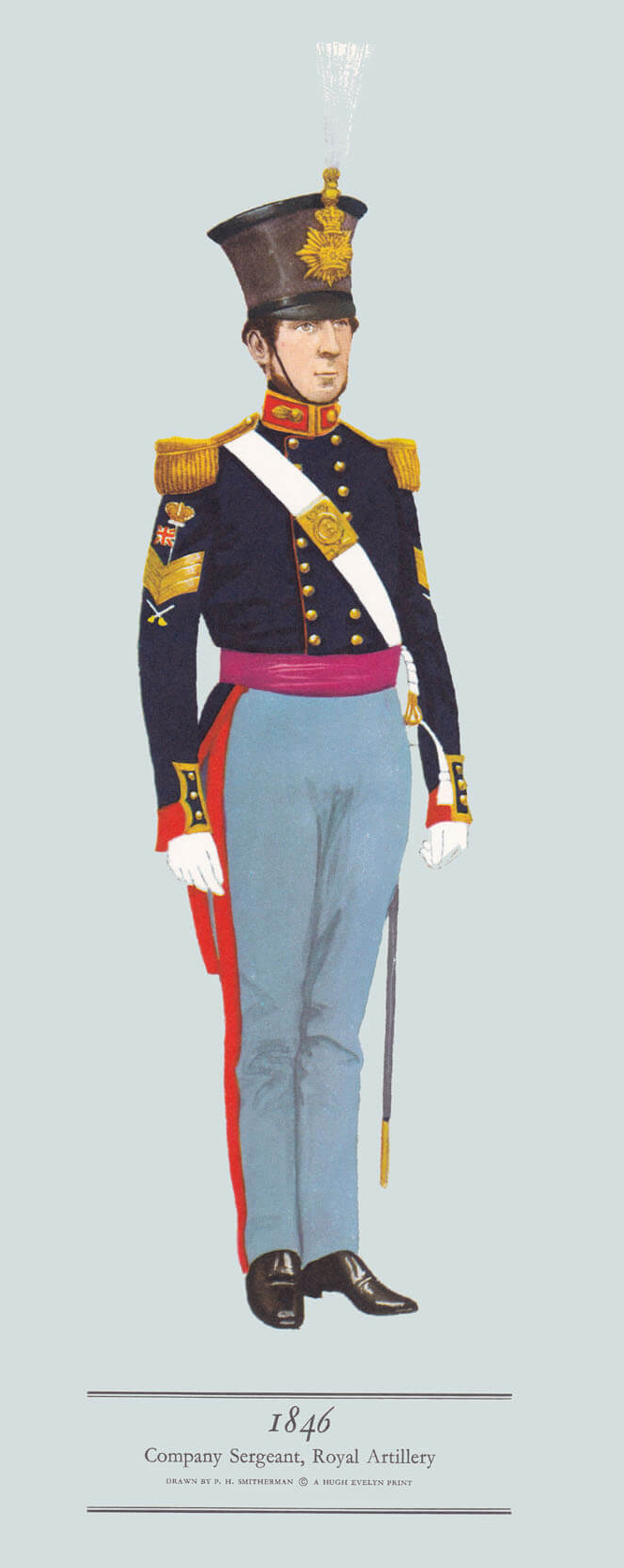 In 1846 Henry's younger brother Nicholas McNally (1824/29 -1874) had aso enlisted into the Royal Artillery as a gunner. His attestation papers show that he was born at Seagoe just 6 miles west of Lurgan and 8 from Magheralin where Henry was born(34). He married Jane Rogers at Seagoe in 1848 and on Henry's return from the West Indies in Feb 1854 was already living in Red Lion Street close to Woolwich Common, not far from Woolwich Arsenal itself. They decided to move in together, living nearer to the Arsenal at 11 Hope Place in Sandy Hill Road. Hope Place was a row of 13 small houses (numbered 9 to 33 Sandy Hill Road) that were relatively new having been built during 1851-1852(35).
In 1846 Henry's younger brother Nicholas McNally (1824/29 -1874) had aso enlisted into the Royal Artillery as a gunner. His attestation papers show that he was born at Seagoe just 6 miles west of Lurgan and 8 from Magheralin where Henry was born(34). He married Jane Rogers at Seagoe in 1848 and on Henry's return from the West Indies in Feb 1854 was already living in Red Lion Street close to Woolwich Common, not far from Woolwich Arsenal itself. They decided to move in together, living nearer to the Arsenal at 11 Hope Place in Sandy Hill Road. Hope Place was a row of 13 small houses (numbered 9 to 33 Sandy Hill Road) that were relatively new having been built during 1851-1852(35). At first Hope Place lived up to it's name as on 13th July 1854 Henry was promoted to the rank of Sergeant and temporarily transferred to the 3rd Company of the 1st Battalion which was on duty at Sheerness. [Note:- See picture right showing the standard dress uniform of a Company Sergeant still in use in 1854] The extra pay would come in handy as he had not long learned that Mary was pregnant again with their 5th child. Although Sheerness is on the coast and over 40 miles to the east they all continued to live at 11 Hope Place. There was no difficulty over transport and Henry no doubt had overnight digs at Sheerness and would have been reassured that his brother Nicholas and sister-in-law Jane were on hand to help Mary with their 3 surviving children should the need arise. On the 25th November 1854 Mary gave birth to a baby boy at 11 Hope Place whom they named Charles McNally and Jane, Nicholas's wife was also pregnant.
16. Death of Alice and Charles McNally - 1855 Before he could get into his new job however tragedy struck when Alice, still only 8 years 4 months old, contracted a fever. This was to last for a month before internal haemorrhaging occurred which lasted another three days before she died in his presence on 13th April 1855. Alice was buried at St Mary Magdalene Church in Woolwich on 2nd May 1855. Unfortunately she seems to have infected Charles who was still only 5 months old. They quickly had him privately baptised at St Mary's on 19th April 1855 and he was buried with Alice 3 days later on 22nd. All these documents show Hope place as their residence. 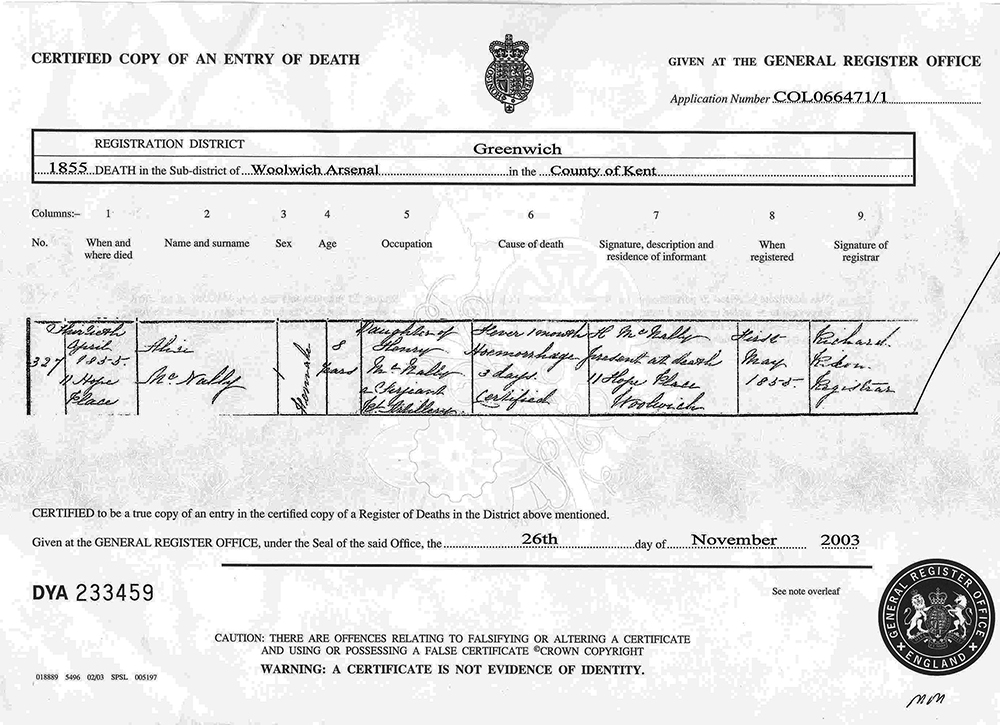 In July 1855 there was one final, thankfully happy, event at 11 Hope place when Jane gave birth to a baby boy on 23rd July 1855. They named him Nicholas after his father (the 2nd child of this name as the first Nicholas McNally was born in Jan 1853 and died 3 months later). This Nicholas was duly baptised at St Mary's on 19th Aug 1855 and went on to live until 1912 and have 10 children. There were five Sergeants in the new Regiment who took it in turns to attend recruiting drives throughout England, Henry spending a month in Dover in July and a month in Canterbury in September 1855. In this way they rapidly expanded the strength of the companies. Number One Company for example only had two gunners on Henry's arrival in April. By July there were 122 so there was a certain amount of transferring to maintain experience and the strength then levelled out at 100-110. The Company was initially based at Dover (by October 1855) and Henry as a married man with children was allowed to find his own lodgings outside the barracks. By 1st Jan 1856 Henry and Mary and his family were all living at No.8 Hartley Street Hougham(36). 17. Birth of Twins - James and William McNally - 1856  From the Illustrated London News, 1869. Left to right Heights Barracks, Military Hospital, and Married Quarters at Hougham Dover It was here that to Henry’s great joy Mary gave birth to twin boys. They were named James and William Mc Nally and born together on 9th April 1856 at 8 Hartley Street. Whether William was damaged during birth or contracted a fever we will never know but he was seriously ill in August so they had him baptised at St Mary-the-Virgin church in Cannon St in Dover on 23rd Aug 1856. Sadly he died on 6th September before dying of Convulsions which had lasted for 17days. Henry seems to have tried to do the best he could for the child as his death is recorded at Heights Barracks Hougham, and this is almost certainly because he was in the Military Hospital there(37). He was buried on the 9th September at Saint James burial ground in Dover. Henry returned to the task of building up the new Regiment and on 1st January 1857 he was upgraded to 4th class good conduct pay. In April however the 14th Battalion went to Canada and Henry was transferred to the Adjutants detachment. There then followed between 1st April 1857 and 3rd April 1859 two years disembodied service with the Durham Artillery Militia.(38) This only counted as half time for pension purposes. In 1852 the regular Militia force had been reorganised with a quota of 80,000 men to be raised by voluntary enlistment. In 1853 the quota of men to be found by the County of Durham was 2,000 and an Artillery Unit was formed as the Durham Regiment of Militia Artillery. Henry was one of a number of regulars posted to the unit to help with training 18. Birth William McNally (1858) and Thomas Nicholas McNally (1860) (2nd child of that name) Completion of Service & Discharge from the Army - 1860 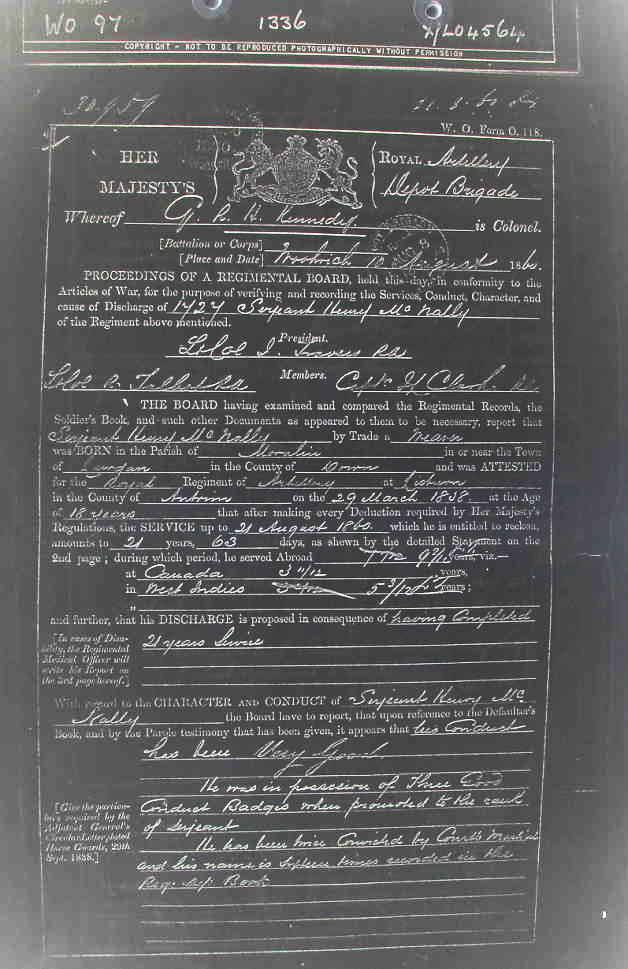 WO 97/1336 : 1st Page only of his discharge papers
Their 10th child was Edith Maud McNally but I have not been able to locate a birth registration or baptism. Nevertheless she appears in every Census return living with the family up to and including 1901. She never married and took care of her mother after her father's death in 1884 and was the informant on her mothers death certificate on 27th Dec 1904 when they were living at 9 Potters Alms Houses in Leeds but we are getting ahead of our selves. Henry McNally Junior (1849-1887) became the first of their children to leave home when he followed his father by enlisting into the Royal Artillery in 1863. [Link to a separate account of his life] The following year in 1864 Henry and his family returned to Armagh in Ireland to live for a couple of years. It was at Blackwatertown Armagh that Mary gave birth to their 11th child on 13th Oct 1864 whom they named Frederick McKinstry McNally(41). Blackwatertown lies just 2 miles south of Charlemont which was where Mary had given birth to thier 1st child Alice in Dec 1846 and may indicate that they still had family in this area. Unfortunately Charlemont parish registers have not so far been transcribed (2021). Frederick McKinstry McNally's death is registered at Charlemont as being on 24th June 1865. Their 12th child Walter McKinstry McNally was also born at Blackwatertown on 5th Oct 1865(42) but early in 1866 they had returned to England settling to live in the growing City of Leeds in Yorkshire. It was here that Walter contracted a lung infection and died of croup aged 1 year on 10th October 1866 simply referred to as Walter McNally. His death Certificate shows that they were living at No.13 Wellington Lane in Leeds and Henry had obtained a job as a letter carrier.
By 1801 the population of Leeds had reached 30,000. By the standards of the time it was already a large town. By 1851 it was spreading rapidly and had reached 101,000, but many of the new houses were dreadful. Overcrowding was rife and streets were very dirty. As a result there was a cholera epidemic in 1832 which killed over 700 people. A second epidemic in 1849 killed more than 2,000. In the 1850s the council built sewers but most houses in Leeds were not connected to them. Many dwellings continued to use cess pits or buckets which were emptied at night by the 'night soil' men. Not until 1899 was it made compulsory for dwellings to be connected to sewers. Their 13th and final child they named Walter Percy McNally and he was born on 28th January 1869 by which time they had moved to live in Christopher Street in Leeds and Henry was still working as a letter carrier. The family was still at Christopher Street on 3rd April 1871 when the Census(43) was taken, although Henry is described as an outworker and pensioner, Frances Ann his daughter (referred to as Fanny) now aged 20 is working as a general servant and the 13 year old William is already a telegraph employee. Clara Highwood (Link to Henry McNally Junior when available) travelled to Leeds in 1877 and stayed with Frances and her three children before the wedding of Clara in Leeds Registry Office to her brother Henry McNally junior on 8th September 187740. By then Henry McNally senior and family had moved from Christopher Street to live at Number 1 Mark Lane Leeds, which is now the short strip of road behind Alders on the Headrow. There is sadly nothing left of the old houses but the head high stone wall on the other side of the road is still there surrounding St Johns Church and graveyard which must have faced them every morning when they left their house. By 4th April 1881 when the next Census was taken both William and Nicholas had left home leaving Henry and Mary with just James, Edith and Walter for company.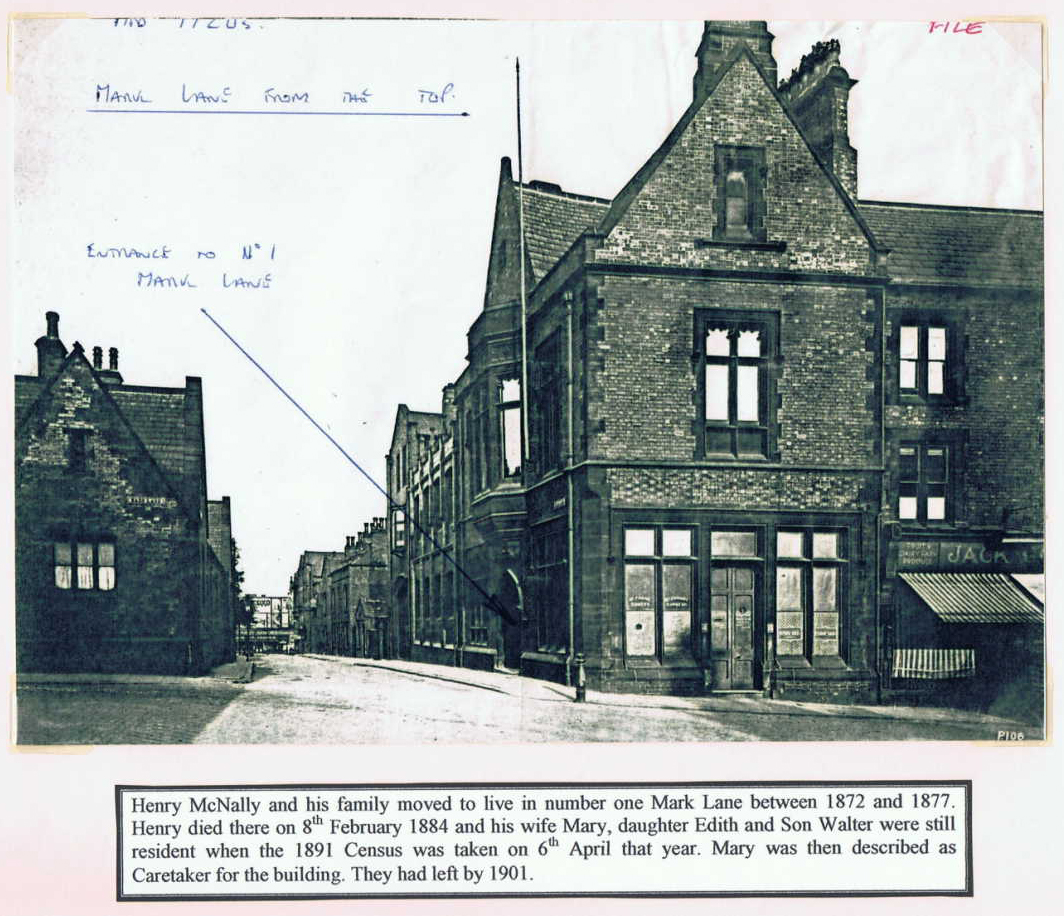 Mary was present when at the age of 64 Henry was to die at 1 Mark Lane in Leeds on 8th February 1884 from “a disease of the brain.”. Mary, Edith, and Walter were still living there on 6th April 1891 when the Census was taken, Mary being described as a caretaker for the building. On 25th October 1893 Walter was still living there when he married Ann Byrom (1874-1956) , the daughter of an enamled slate manufacturer, William Byrom (1837-1904) by his wife Janet Grieve (1839-1912) who lived nearby at number 10 Victoria Place. James also seems to have departed during this period, probably to get married, and this left Mary and Edith living together. With the death of Henry they had lost Henry’s Pension and by 1st April 1901 they had moved to live at Number 9 Potters Almshouses in Leeds. The houses had been erected as long ago as 1736 by a benefactor called Mary Potter. Sadly our Mary was to die here at the age of 78 on Christmas day in the year 1904 from an acute attack of Bronchitis.
2. Henry McNALLY Junior (1849-1887) --- My great grandparents -- To be Linked to a more datiled separate account. Born and baptised on the Island of Dominica in the West Indies in 1849 he returned with his parents to England in 1853 on board HMS.Vulcan. In 1863 aged 16 he enlisted as a trumpeter at Woolwich into the Royal Artillery and received his training at Gosport, Sandown and Plymouth. Appointed Gunner in 1867 he completed schooling in 1868 at Woolwich and gained promotion to Bombadier. In 1869 he transfered to the gunnery ranges at Shoeburyness in Essex where he met Clara HIGHWOOD, They were to marry twice, 1st at the Registry Office in Leeds in 1877 and later at the Chapel in Halifax Nova Scotia in Canada. They were to have 6 children between 1870-1886. In 1880 he transferred with his Regiment to Malta and named their 3rd child William Angelo McNally after Fort St Angelo on the Island. During the Egyptian Campaige In 1882 he was transferred to 1st Brigade 5th Battery and took part inThe Battle of Kassassin on 28th August that year. To celebrate his survival they named their 4th child born the following year as Walter Kassassin McNally. He was posted home in January 1884 and medically discharged as unfit from the Army in November. He had a stroke and died on 4th Feb 1887 and according to my uncle Christopher McNally both he and Clara were buried at St Andrews churchyard Shoeburyness ('right in the corner near left side). Certainly Clara returned to Shoeburyness after he died living in Cambridge Road. 3. Frances Ann McNALLY (1851-1926) Born on the Island of Dominica in the West Indies in 1851 she returned with her parents to England in 1853 on board HMS.Vulcan and remained with them living in Leeds until she married there in St Peters Church in May 1871 to James George RELTON (1847-1891). James was the son of a Carpenter James Relton by his wife Mary Winterburn They lived at 28 Clifford Street in Leeds and had 9 children there between 1873 and 1891. James died there in 1891 but Francis lived until 13th April 1926. She was buried at Leeds general cemetery on the 17th. 4. Unnamed McNALLY (1853-1853) Mary gave birth at 4.30 am on 5th Nov 1853 to a still born child whilst at sea on board HMS.Vulcan having embarked with her husbands Regiment at Barbados the day before. The entry in the ships log simply states " Departed this life the infant of Corporal McNally". There is a further entry at 1.40pm "Committed the body of the deceased to the deep" when the ships position was noted as being 183 miles north and 161 miles west of Barbados. 5. Charles McNALLY (1854-1855) Born on 25th Nov 1854 at 11 Hope Place in the house they shared with his fathers brother Nicholas McNally and his family. He was baptised at St Mary Magdalene Church in Woolwich on 19th April 1855 and died 3 days later. 6. James McNALLY (1856-1923) Twin with William born 9th April 1855 at 8 Hartley Street Hougham Dover in Kent. He remained with his parents and was living at Catherine Square Greenwich in 1861 but later became ill and had to be admitted to the Herbert Military Hospital at Shooters Hill Woolwich in Kent. This was a new hospital opened on 1st Nov 1865 and he is there in the 1871 Census taken on 2nd April, but back with the family living at 1 Mark Lane in Leeds City center on 3rd Apr 1881. On 3rd June that year he enlisted in to the Royal Artillery and was transferred on 13th March 1882 to the 10th Brigade Scottish Div RA serving in Malta. He is recorded as serving on active duty during the Egyptian campaign from 9th Aug to 9th Oct 1882 and awarded a silver medal and Khedive Bronze Star. Made a bombadier in 1883 and Corporal on 1st March 1884 he subsequently fell foul of military discipine and was tried at garrison court martial on 27th Nov 1884 and reduced to the rank of gunner and forfeited his good conduct pay. The murder of General Gordon at Kahartoum on 26th January 1885 meant his Regiment being transferred from Egypt on 15th March 1885 to active service in Eastern Sudan where he served for 78 days until 14th May when they returned to Egypt. On 5th July 1885 he transferred home and to the 4/1 Scottish Divsion and by 1888 his good conduct pay had been restored. On 26th April 1888 he married Mary Annie SHEWRING at the registry office in Eltham Kent. They were to have 10 children between 1888 and 1910. He was discharged from the Army on 9th June 1893 having completed 12 years service. They settled at Eastleigh Hampshire and James died aged 66 at number 89 in the high street and was buried at Eastleigh Cemetery on 31st August 1923. He was joined by Mary Ann who was still living at 89 the High street aged 79 on 20th April 1946. 7. William McNALLY (1856-1856) Twin with James born 9th April 1855 at Hougham Dover but died aged 4 months of convulsions and buried at St James burial ground Dover. 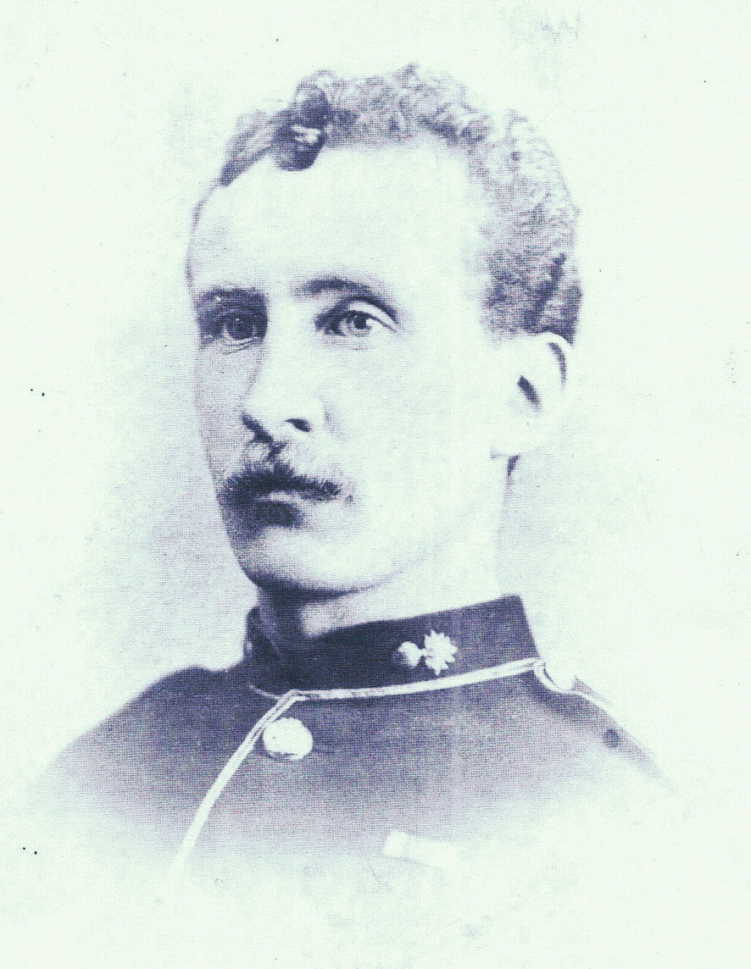 8. William McNALLY (1858-1902) Born on 8th March 1858 at Bondgate, Bishop Auckland, in Durham. In 1872 at the age of 14 he enlisted into the Royal Artillery at Sheffield and was transferred to the 3rd Brigade as a trumpeter in 1873. In 1876 he was sent to Shoeburyness in Essex for weapons training and promoted to the rank of gunner in May 1877 transferring to the 5th Brigade in July. He was posted overseas to Colaba in India in Dec1878 and awarded campaign medals for service in Afganistan for the years 1878; 1879 and 1880. He was promoted to Corporal in 1879, and Sergeant in 1880. In 1884 he was re-engaged to complete 21 years service at Rawalpindi and promoted to Battery Serjeant Major of the 1st Brigade Scottish Rifles in 1885 when he finally left india. He then served in Aden for a year before retuning to Woolwich Arsenal in Kent at the end of 1886. Here he married on 27th Dec 1887 at the Registry Office in Woolwich to Elizabeth Jane WRIGHT the daughter of a shipwright John Wright by his wife Mary Ann Penman. They were to have 4 children as shown below. William McNally Senior returned with his family to England in July 1896 and was discharged from the Army on 25th Aug 1896 having been awarded a pension and a Silver Medal for long service and good conduct. They lived initially at his fathers address of 1 Mark Lane in Leeds where their fourth and final child was born in 1898. By 1901 they had moved to 69 Burley Lodge Road in nearby Headingly in Yorksire where William died on 1st March 1902, still only aged 43, his death certificate recording cardiac failure. Elizabeth moved her family to live at 6 Ordnance Terrace in Chatham in Kent and died at the age og 76 during 1st qtr of 1937.
8. William McNALLY (1858-1902) Born on 8th March 1858 at Bondgate, Bishop Auckland, in Durham. In 1872 at the age of 14 he enlisted into the Royal Artillery at Sheffield and was transferred to the 3rd Brigade as a trumpeter in 1873. In 1876 he was sent to Shoeburyness in Essex for weapons training and promoted to the rank of gunner in May 1877 transferring to the 5th Brigade in July. He was posted overseas to Colaba in India in Dec1878 and awarded campaign medals for service in Afganistan for the years 1878; 1879 and 1880. He was promoted to Corporal in 1879, and Sergeant in 1880. In 1884 he was re-engaged to complete 21 years service at Rawalpindi and promoted to Battery Serjeant Major of the 1st Brigade Scottish Rifles in 1885 when he finally left india. He then served in Aden for a year before retuning to Woolwich Arsenal in Kent at the end of 1886. Here he married on 27th Dec 1887 at the Registry Office in Woolwich to Elizabeth Jane WRIGHT the daughter of a shipwright John Wright by his wife Mary Ann Penman. They were to have 4 children as shown below. William McNally Senior returned with his family to England in July 1896 and was discharged from the Army on 25th Aug 1896 having been awarded a pension and a Silver Medal for long service and good conduct. They lived initially at his fathers address of 1 Mark Lane in Leeds where their fourth and final child was born in 1898. By 1901 they had moved to 69 Burley Lodge Road in nearby Headingly in Yorksire where William died on 1st March 1902, still only aged 43, his death certificate recording cardiac failure. Elizabeth moved her family to live at 6 Ordnance Terrace in Chatham in Kent and died at the age og 76 during 1st qtr of 1937.
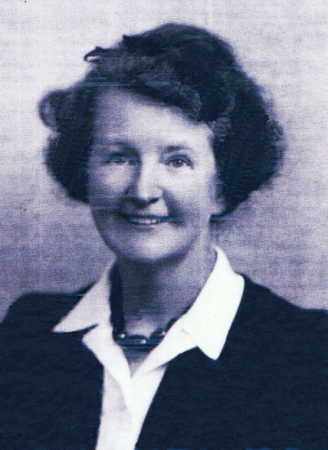 (8.2 Edith Mary Hoben McNally (1893-1963) born at Cape Town South Africa in Jan 1893 and baptised in the Garrison Chapel there the following month. She moved with her parents until marriage in Jan 1917 to John Wiliam Cook (1881-1923) a stoker in the Royal Navy. They had 2 children (Basil J born Nov 1917 who only lived a month and Bettine Edith born in 1920. John William died aged 41 in 1923. During his service with the Royal Navy he served on a number of well known ships such as HMS Jupiter; HMS Irresisible; HMS Britannia; HMS Leander etc.
(8.2 Edith Mary Hoben McNally (1893-1963) born at Cape Town South Africa in Jan 1893 and baptised in the Garrison Chapel there the following month. She moved with her parents until marriage in Jan 1917 to John Wiliam Cook (1881-1923) a stoker in the Royal Navy. They had 2 children (Basil J born Nov 1917 who only lived a month and Bettine Edith born in 1920. John William died aged 41 in 1923. During his service with the Royal Navy he served on a number of well known ships such as HMS Jupiter; HMS Irresisible; HMS Britannia; HMS Leander etc.Edith remarried to Robert William Belsom in 1925 by whom she had 2 more children (Marjorie Edith in 1925 and Donald W in 1928). In the 1939 war census they were living at 378 Wherstead Road in Suffolk. Edith died aged 69 on 6th Jan 1963 in Suffolk. 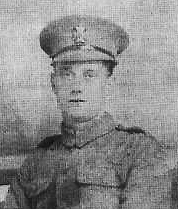 (8.3) Harry McNally (1895-1977). Also born and baptised at Cape Town South Africa in 1895. In 1911 aged 15 he is recorded in the census as a member of the 'House Boys', Brigade resident at 31 Elizabeth St in Pimlico. I suspect this was a military training school all the boys being teenagers. Harry like his elder brother was to join the British Army during 1st World War serving as Soldier 20966 in the 10th Battalion of the Essex Regiment. In addition to the standard Military medals he was also awarded the Military Medal for bravery in the field. He married on 23rd Dec 1922 at St Margarets church in Rochester Kent to Alice Mabel Barden (1895-1984) and they had a son Desmond Henry C McNally (1925-1997). They were resident at 9c Langley Road in Rochester Kent in the Sept 1939 war Census and Harry died aged 82 in 1977.
(8.3) Harry McNally (1895-1977). Also born and baptised at Cape Town South Africa in 1895. In 1911 aged 15 he is recorded in the census as a member of the 'House Boys', Brigade resident at 31 Elizabeth St in Pimlico. I suspect this was a military training school all the boys being teenagers. Harry like his elder brother was to join the British Army during 1st World War serving as Soldier 20966 in the 10th Battalion of the Essex Regiment. In addition to the standard Military medals he was also awarded the Military Medal for bravery in the field. He married on 23rd Dec 1922 at St Margarets church in Rochester Kent to Alice Mabel Barden (1895-1984) and they had a son Desmond Henry C McNally (1925-1997). They were resident at 9c Langley Road in Rochester Kent in the Sept 1939 war Census and Harry died aged 82 in 1977. (8.4 Florence Mariane McNally (1898-1917) Florence was born at her grandfathers house at 1 Mark Lane in Leeds on 25th Jan 1898 and baptised at St John the Evangelist church on 7th March. She moved with her parents; in 1901 they were in Headingley and 1911 in Chatham Kent. In Jan 1917 she was a witness at her sister Edith's wedding but she died aged only 19 on 28th May that year with her death certificate recording the cause of death as 'mitral reguritations' at 6 Ordnance Terrace in Chatham Kent. 9. Thomas Nicholas McNALLY (1860-1890) Born at the Parkhurst Military Garrison on the Isle of Wight early in 1860 he enlisted into the Royal Artillery as Soldier 5971 at Sheffield as a boy aged 15 on 6th July 1875. His Military career laster for just over 12 years and was all served in England apart from a period 1878/1882 in Armagh Ireland. He was discharged as medically unfit at Devonport in 1887 and returned to live with his parents at 1 Mark Lane Leeds where he died from Phthisis (T.B.) on 26th Sep 1890. He was buried 3 days later at Beckett St cemetery in Leeds. 10. Edith Maud McNALLY (1862/3-1944) Many records relating to her are missing. We have not been able to identify a registration of birth at the GRO or baptism elsewhere but her place of birth is given in all 4 Census returns as Chatham in Kent circa 1863. These returns show that she remained a spinster living with her parents throughout her life and was working in Leeds as a machinist in 1881 and a braider of jackets in 1891. She was also a witness at the wedding of her brother Walter Percy McNally at Leeds Registry Office in 1893. Walter's departure from the family home meant that Edith and her mother could no longer afford to stay at 1 Mark Lane in Leeds and by March 1901 they had been granted accommodation in one of the nearby Potters Almshouses. Her mother now aged 78 died there on Christmas day 1904. I have not been able to locate Edith as having subsequently married, or in the 1911 or 1939 Census returns. There is one solitary entry in the Ripon, Yorkshire Electoral Register for an Edith Maud McNally of 62 Dragon Avenue for the year 1935 and a death at the GRO for an Edith M McNally aged 81 at Knareborough which I have had to assume his her until further information comes to light. 11. Frederick McKinstry McNALLY (1864-1865) Born at Blackwatertown in the County of Armagh in Ireland on 13th Oct 1864 died aged 7 months on 24th June 1865 recorded at Charlemont Ireland. Blackwatertown lies just 4km south of Charlemont both on the river blackwater. 12. Walter McKinstry McNALLY (1865-1866) Born at Blackwatertown in the County of Armagh in Ireland on 5th Aug 1865. He returned to England with his parents to live at Wellington Lane in Leeds where he died of croup on 10th Oct 1866. 13. Walter Percy McNALLY (1869-1898) Born at Christopher Street Leeds on 28th Jan 1869 he remained living with his parents until he married training to be an engineers fitter. He married at the Registry Office in Leeds on 25th Oct 1893 to Annie BYROM the daughter of William BYROM (1837-1904) a manufacturer of enamel slate goods by his wife Janet Grieve. They had 4 children, the first being born prematurly and only living for 6 hours and the other three all girls :- (Dora Byrom Macnally (1895-1961) , Mabel Mc Nally (1896-1896) and Janet Grieve McNally (1897-1975).. Genealogical Notes:- (1) Henry McNally (Senior) (1819-1884) WO69/85 Soldier 1645 Attestation Papers 29th March 1838 he stated his birth place was Maralin near Lurgan Ireland. Maralin is an older form of Magheralin - See also Army Discharge Papers 1860/1408/49 - WO97/1336 (2) On enlistment Henry McNally Senior refers to his place of birth as Maralin near Lurgan but in the 1871 Census he also refers to his birthplace as Banbridge. (3) The Irish Potato Famine was a period of mass starvation lasting from 1845 to 1852 when succesive years of harvest failed because of potato blight. The worst year was 1847. About 1 million people died and amother million permanently emigrated. (4) I have a time line excel spreadsheet recording every known document / event in Henry McNally's life (11 foolscap sheets). Most entries relate to tracing his progress every month through the Regimental Pay Musters which start under WO101733 [110] on 30th June 1838. These not only record his pay, deductions, reason eg. in hospital, location, promotion, imprisonment, discharge etc and provide clues to the whereabouts of other documents relating to him. Particularly useful when transfering from one regiment or battalion to another as they even record the name of ships embarked on to transfer abroad from which I was able to locate ships logs about the voyage. Luckily I was able to do this as the Public Records Office was then in Chancery Lane London and I spent each lunch hour for over a year looking at the original files. (5) WO10/1756/62 Recorded as sick (6) The ship Stakesby: Ref on Royal Artillery Pay Muster WO/10/1756/61 - See also lloyds Register -Stakesby Barque felt and sheathed 1835. Master Goble, 438 tons, built Whitby 1814. Owners Chapman 1829. Belonging to the port of London destined voyage London to Quebec (7) Extract from "The New Empire 1783-1870 Volume II 1853" (8) Extract from "The Cambridge History of the British Empire" Volume VI (9) Extract from 'Colonial Small Wars' 1837 -1901 by Donald Featherston Published 1973 (10a) The following hospitalisations are recorded in the pay musters:-
1st Oct 1839 in Hospital 9d deducted from pay - WO10/1769/68 27th to 31st Jan 1840 in hospital 13s. 9d deducted from pay by order of the commanding officer agreeable to 2nd section clause 52 of Articles of War- WO10/1797 1st Feb to 17th Mar 1840 inclusive sick. £1.1s.9d deducted in Feb and 12s 9d in March.WO10/1797/62 and 63. 11th to 16th Nov 1840 Royal Ornance Hospital Toronto. 4s.6d deducted - WO10/1824/55 8th to 18th March 1841 Imprisoned awaiting trial - WO10/1824/55 (11) WO10/1853/47 13s 6d stopped sick 18 days 14th to 31st Aug 1842 and WO10/1853/50 11s 3d stopped still sick 15 days from 1st to 15th Sep 1842 (12) Garrison Court Martial Royal Artillery Records War Office Ref WO/86/4 (13) WO10/1871 - List of men of No. 7 Company 1st Battalion Royal Artillery who are undergoing stoppage of pay for Habitual Drunkenness during Dec 1842 (14) WO10/1874/49 Pay Musters Embarked on 'PEDEL' Freight Ship 10th June 1843 at Quebec. Henry McNally on detatched duty at Purfleet WO10/1874/4531 Aug 1843 and WO10/1874/42 April 1844; Queens Works Woolwich WO10/1874/41 31 Aug 1844 (15) WO10/1874/42 and 43 Pay Musters Travel Woolwich to Dublin. Pay Musters refer to Portobello/Dublin from May to Sep WO10/1909/43 and 46 but Oct 1845 to March 1846 records did not survive and from April 1846 to Sep 1846 [WO10/1931] records were not fit for production in 2003. Annoying as met Mary HOBEN during this period. Appear to be in Dublin but next available record 31 Oct 1846 WO10/1952/22 Company has moved to Charlemont Ireland. (16) Mountrath Catholic Marriages are on ancestry.com under "Ireland, Select Catholic Marriage Registers, 1778-1942" but there are no Henry's that marry in the period Henry McNally was at Dublin May 1845 to Dec 1846 when Alice is born at Charlemont. Could not locate elsewhere e.g. Regimental Marriages or Dublin. We are hampered by RA Muster Records not surviving or being available for this period. (17) Regimental Pay Musters for Charlemont: WO10/1952 [22/24/25] WO10/1953 [21/19] WO101983 [18/16 (Dublin)]. WO10/1984[16 and 13 Portobello North Dublin Bay] WO10/1984/11 Death of Gunner Francis Kearney - Henry McNally on Guard Duty Queens works --bought 2 towels, 1 pair of blue trousers, 1 coatee for 1s 3d of his effects - money collected would go to his widow. (18) WO10/1977 Guard Duty Tower of London (19) Royal Artillery Pay Muster WO10/2003/10 Embarked on ship 'ATHOL' at Woolwich Docks . Also entry in Times Newspaper for 12th Oct 1848 Page 3. Debarked Gun Hill Barbardos 31st Oct 1848 Henry Assigned to unit on Island of Dominica arriving there on 22nd Nov 1848. (20) The Ships Log of the 'ATHOL'has survived and I viewed it at the National Archies at Kew Gardens. It does not however have any entries of interest except for 20th Oct 1848 whilst Henry Mary and Alice were on board and shows that a Marine Patrick Brody was punished with 24 lashes for disobedience of orders and insolence. (21) Royal Artillery Pay Muster WO10/1991 Arrival in Dominica 22nd Nov 1848 (22) Extract from Dictionary of English History by Low & Pulling dated 1928. (23) Royal Artillery Register of Births and Baptisms Birth of Henry McNally Junior 30th March 1849 Entry No. in Register 2262 - 1849/3003/37 (24) Royal Artillery Pay Muster WO10/2018 for June 1849 also contains a Good Conduct Pay Certificate Signed Copy taken at Public Records Office - Total number of years service after the age of 18 - 11years 1 month - Date of last entry in defaulters book 18th Oct 1844 - 6th offence - Date at which soldier became entitled 19th Oct 1848 (25) Royal Artillery Pay Muster WO10/2045 Embarked Steamer Meadway (26) PO B48 Ships Letters Extract from Post Office Records regarding Medway obtained 11th Mar 1980. (27) Frances Ann McNALLY (1851-1926) Her birth is not recorded in the surviving Registers of the Royal Artillery but a direct descendant (Paul Relton) advises that she was born on the Island on 2nd April 1851. She married in Leeds 15th May 1871 to James (George) RELTON and gives the Island of Dominica as her birthplace in all Census returns from 1861 to 1901 inc. (28) Royal Artillery Pay Muster WO10/2098/4 Promotion to Corporal acknowledged as Denis Morgan prior Corporal reduced to the rank of gunner 15th May 1851. In Nov unit left in charge of 2 Corporals until January when Ensigne HB Brody 69th Regt arrived (29) Royal Artillery Pay Muster WO10/2098/4 Nov 1851 Left in joint charge of the detatchment with another Corporal Ensign HB Brody 69th Regt taking charge the following month (30) Royal Artillery Pay Muster WO 10/2134 Royal Artillery withdrawl from St Vincent 11th May 1853 & muster at Barbados (31) Plans for HMS Vulcan survive at the National Maritime Museum and The National Historical Library Ref: 1853/0411/OB 1853/0411/OA (32) Ships Log HMS Vulcan ADM 53/5737 - 1853/0411/OA (33) Royal Artillery Pay Muster WO10/2193 Transfer 1st Co of a new Battalion 14th. Henry McNally joined Captain DS Green also transferred by augmentation on 1st April. (34) Birth of Nicholas McNally There are 5 documents which purport to give his age (Note his name has been spelt as McNally, McAnally, McNelly)We know he was illiterate as both his marriage certificate and the
2. His Marriage Certificate 24th Jan 1848 - aged 24 (Jan 1824) 3. April 1851 Census - aged 22 (1829) 4. RA Discharge Papers 11 Oct 1870 aged 43 (1827) 5. 1871 Census age 42 (1829) (36) WO10/2225/2 RA Pay Muster includes Form 24 Return of allowances paid to a married man to find their own lodgings out of barracks - shows Henry McNally paid the sum of 15s 2d for 91 days from 1st Jan 1856 to 31st March 1856. Only such return located in the pay musters (37) GRO Birth and Death Certificates held: James and William McNally Births 2nd qtr 1856 District Dover Ref 21 635 - father Henry McNally mother Mary McNally nee Hoben; Williams death GRO 3rd qtr 1856 2a 424. Burial CLDS Film 1786362 ID 123 (38) Royal Artillery Pay Muster WO10/2279 Royal Artillery Institution Ref 1980/2505/00. Dorset Militia Records have not survived from 1st Oct 1857 to 4th April 1859. (39) Chelsea Hospital Pension Register WO16 133/5940 [Note:- did not have time to investigate WO 23 which might be relevant] (40) 1861 CensusRG9/406/31/61 Parish of Woolwich See also the excellent account of the history of the Cardwell and Woodhill areas of Woolwich. 5 Catherine Square (41) CLDS Film 101095 birth of Frederick McKinstry McNally born 13th Oct 1864 Blackwaterdown Armagh Ireland father Henry McNally mother Mary nee Hoben (42) Irish Births Walter McKinstry McNally son of Henry McNally and Mary nee Hoben 1865 Registration District Armagh Ireland Volume 11 Page 77 CLDS Film No. 101042 (43) 1871 Census Night of 2nd/3rd April: RG10/4563/Page 35 Folio 166. Christopher Street Leeds |